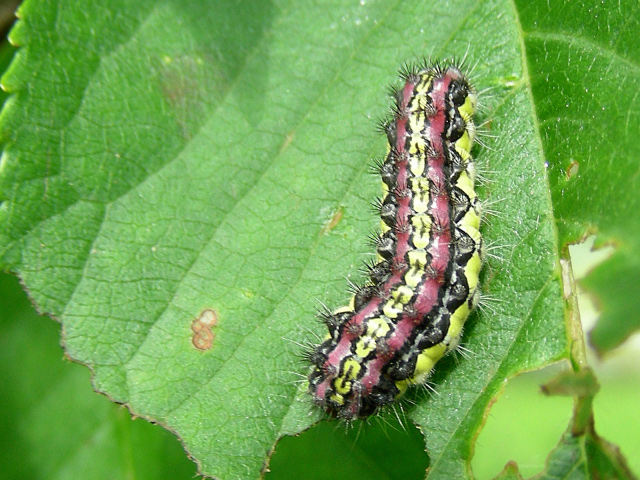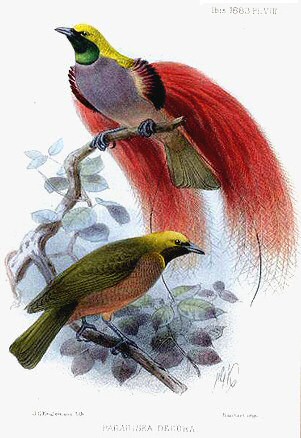|
Aglaope Infausta
''Aglaope infausta'', or almond-tree leaf skeletonizer moth, is a moth of the family Zygaenidae. Description The wings are gray with some red towards the base. The thorax is black and is crossed with a red band. The wingspan is about . The caterpillar can retract its head into its prothorax. A yellow band with black spots runs along the caterpillar's dorsum. The pupation usually starts in early June as an elongated cocoon that is whitish or light brown. The pupa is pink or yellowish and is long. The larvae feed upon '' Prunus spinosa'', ''Crataegus'' sp., ''Cotoneaster'' sp., and other species in the family Rosaceae. The species is a pest on foliage and young fruit. The species shows a very low level of genetic heterogeneity for a lepidopteran species, but it does not affect the species' viability. In the Ice Age, differentiation into two genetic lineages occurred. Mating The external male sex organs are subject to sexual selection by the female. The male may rub the f ... [...More Info...] [...Related Items...] OR: [Wikipedia] [Google] [Baidu] |
Carl Linnaeus
Carl Linnaeus (; 23 May 1707 – 10 January 1778), also known after his ennoblement in 1761 as Carl von Linné Blunt (2004), p. 171. (), was a Swedish botanist, zoologist, taxonomist, and physician who formalised binomial nomenclature, the modern system of naming organisms. He is known as the "father of modern taxonomy". Many of his writings were in Latin; his name is rendered in Latin as and, after his 1761 ennoblement, as . Linnaeus was born in Råshult, the countryside of Småland, in southern Sweden. He received most of his higher education at Uppsala University and began giving lectures in botany there in 1730. He lived abroad between 1735 and 1738, where he studied and also published the first edition of his ' in the Netherlands. He then returned to Sweden where he became professor of medicine and botany at Uppsala. In the 1740s, he was sent on several journeys through Sweden to find and classify plants and animals. In the 1750s and 1760s, he continued to coll ... [...More Info...] [...Related Items...] OR: [Wikipedia] [Google] [Baidu] |
Fruit
In botany, a fruit is the seed-bearing structure in flowering plants that is formed from the ovary after flowering. Fruits are the means by which flowering plants (also known as angiosperms) disseminate their seeds. Edible fruits in particular have long propagated using the movements of humans and animals in a symbiotic relationship that is the means for seed dispersal for the one group and nutrition for the other; in fact, humans and many animals have become dependent on fruits as a source of food. Consequently, fruits account for a substantial fraction of the world's agricultural output, and some (such as the apple and the pomegranate) have acquired extensive cultural and symbolic meanings. In common language usage, "fruit" normally means the seed-associated fleshy structures (or produce) of plants that typically are sweet or sour and edible in the raw state, such as apples, bananas, grapes, lemons, oranges, and strawberries. In botanical usage, the term "fruit" als ... [...More Info...] [...Related Items...] OR: [Wikipedia] [Google] [Baidu] |
Spermatophore
A spermatophore or sperm ampulla is a capsule or mass containing spermatozoa created by males of various animal species, especially salamanders and arthropods, and transferred in entirety to the female's ovipore during reproduction. Spermatophores may additionally contain nourishment for the female, in which case it is called a nuptial gift, as in the instance of bush crickets. In the case of the toxic moth '' Utetheisa ornatrix'', the spermatophore includes sperm, nutrients, and pyrrolizidine alkaloids which prevent predation because it is poisonous to most organisms. However, in some species such as the Edith's checkerspot butterfly, the "gift" provides little nutrient value. The weight of the spermatophore transferred at mating has little effect on female reproductive output. Arthropods Spermatophores are the norm in arachnids and several soil arthropods. In various insects, such as bush crickets, the spermatophore is often surrounded by a proteinaceous spermatophyl ... [...More Info...] [...Related Items...] OR: [Wikipedia] [Google] [Baidu] |
Sperm
Sperm is the male reproductive cell, or gamete, in anisogamous forms of sexual reproduction (forms in which there is a larger, female reproductive cell and a smaller, male one). Animals produce motile sperm with a tail known as a flagellum, which are known as spermatozoa, while some red algae and fungi produce non-motile sperm cells, known as spermatia. Flowering plants contain non-motile sperm inside pollen, while some more basal plants like ferns and some gymnosperms have motile sperm. Sperm cells form during the process known as spermatogenesis, which in amniotes (reptiles and mammals) takes place in the seminiferous tubules of the testes. This process involves the production of several successive sperm cell precursors, starting with spermatogonia, which differentiate into spermatocytes. The spermatocytes then undergo meiosis, reducing their chromosome number by half, which produces spermatids. The spermatids then mature and, in animals, construct a tail, or f ... [...More Info...] [...Related Items...] OR: [Wikipedia] [Google] [Baidu] |
Abdomen
The abdomen (colloquially called the belly, tummy, midriff, tucky or stomach) is the part of the body between the thorax (chest) and pelvis, in humans and in other vertebrates. The abdomen is the front part of the abdominal segment of the torso. The area occupied by the abdomen is called the abdominal cavity. In arthropods it is the posterior tagma of the body; it follows the thorax or cephalothorax. In humans, the abdomen stretches from the thorax at the thoracic diaphragm to the pelvis at the pelvic brim. The pelvic brim stretches from the lumbosacral joint (the intervertebral disc between L5 and S1) to the pubic symphysis and is the edge of the pelvic inlet. The space above this inlet and under the thoracic diaphragm is termed the abdominal cavity. The boundary of the abdominal cavity is the abdominal wall in the front and the peritoneal surface at the rear. In vertebrates, the abdomen is a large body cavity enclosed by the abdominal muscles, at front and to ... [...More Info...] [...Related Items...] OR: [Wikipedia] [Google] [Baidu] |
Sexual Selection
Sexual selection is a mode of natural selection in which members of one biological sex choose mates of the other sex to mate with (intersexual selection), and compete with members of the same sex for access to members of the opposite sex (intrasexual selection). These two forms of selection mean that some individuals have greater reproductive success than others within a population, for example because they are more attractive or prefer more attractive partners to produce offspring. Successful males benefit from frequent mating and monopolizing access to one or more fertile females. Females can maximise the return on the energy they invest in reproduction by selecting and mating with the best males. The concept was first articulated by Charles Darwin who wrote of a "second agency" other than natural selection, in which competition between mate candidates could lead to speciation. The theory was given a mathematical basis by Ronald Fisher in the early 20th century. Sexual ... [...More Info...] [...Related Items...] OR: [Wikipedia] [Google] [Baidu] |
Sex Organ
A sex organ (or reproductive organ) is any part of an animal or plant that is involved in sexual reproduction. The reproductive organs together constitute the reproductive system. In animals, the testis in the male, and the ovary in the female, are called the ''primary sex organs''. All others are called ''secondary sex organs'', divided between the external sex organs—the genitals or external genitalia, visible at birth in both sexes—and the internal sex organs. Mosses, ferns, and some similar plants have gametangia for reproductive organs, which are part of the gametophyte. The flowers of flowering plants produce pollen and egg cells, but the sex organs themselves are inside the gametophytes within the pollen and the ovule. Coniferous plants likewise produce their sexually reproductive structures within the gametophytes contained within the cones and pollen. The cones and pollen are not themselves sexual organs. Terminology The ''primary sex organs'' are the gonads, ... [...More Info...] [...Related Items...] OR: [Wikipedia] [Google] [Baidu] |
Journal Of Biogeography
The ''Journal of Biogeography'' is a Peer review, peer-reviewed scientific journal in biogeography that was established in 1974. It covers aspects of spatial, ecological, and historical biogeography. The founding editor-in-chief was David Watts (biogeographer), David Watts, followed by John Flenley, Philip Stott (1987-2004), Robert J. Whittaker (2004-2015), and Hans Peter Linder (biogeographer), Peter Linder (University of Zurich; 2015-2019). The current editor-in-chief is Michael N Dawson (University of California, Merced). Abstracting and indexing The journal is abstracted and indexed in: According to the ''Journal Citation Reports'', the journal has a 2021 impact factor of 4.810. References External links * {{DEFAULTSORT:Journal Of Biogeography Ecology journals English-language journals Geography journals Monthly journals Wiley-Blackwell academic journals Publications established in 1974 ... [...More Info...] [...Related Items...] OR: [Wikipedia] [Google] [Baidu] |
Lineage (evolution)
An evolutionary lineage is a temporal series of populations, organisms, cells, or genes connected by a continuous line of descent from ancestor to descendant.The Oxford English Dictionary defines biological lineage as "a sequence of species each of which is considered to have evolved from its predecessorOED definition of lineage/ref> Lineages are subsets of the evolutionary tree of life. Lineages are often determined by the techniques of molecular systematics. Phylogenetic representation of lineages 299x299px, A rooted tree of life into three ancient monophyletic lineages: archaea.html" ;"title="bacteria, archaea">bacteria, archaea, and eukaryotes based on rRNA genes Lineages are typically visualized as subsets of a phylogenetic tree. A lineage is a single line of descent or linear chain within the tree, while a clade is a (usually branched) monophyletic group, containing a single ancestor and all its descendants. Phylogenetic trees are typically created from DNA, RNA or prot ... [...More Info...] [...Related Items...] OR: [Wikipedia] [Google] [Baidu] |
Viability Selection
Natural selection is the differential survival and reproduction of individuals due to differences in phenotype. It is a key mechanism of evolution, the change in the heritable traits characteristic of a population over generations. Charles Darwin popularised the term "natural selection", contrasting it with artificial selection, which in his view is intentional, whereas natural selection is not. Variation exists within all populations of organisms. This occurs partly because random mutations arise in the genome of an individual organism, and their offspring can inherit such mutations. Throughout the lives of the individuals, their genomes interact with their environments to cause variations in traits. The environment of a genome includes the molecular biology in the cell, other cells, other individuals, populations, species, as well as the abiotic environment. Because individuals with certain variants of the trait tend to survive and reproduce more than individuals with ot ... [...More Info...] [...Related Items...] OR: [Wikipedia] [Google] [Baidu] |







